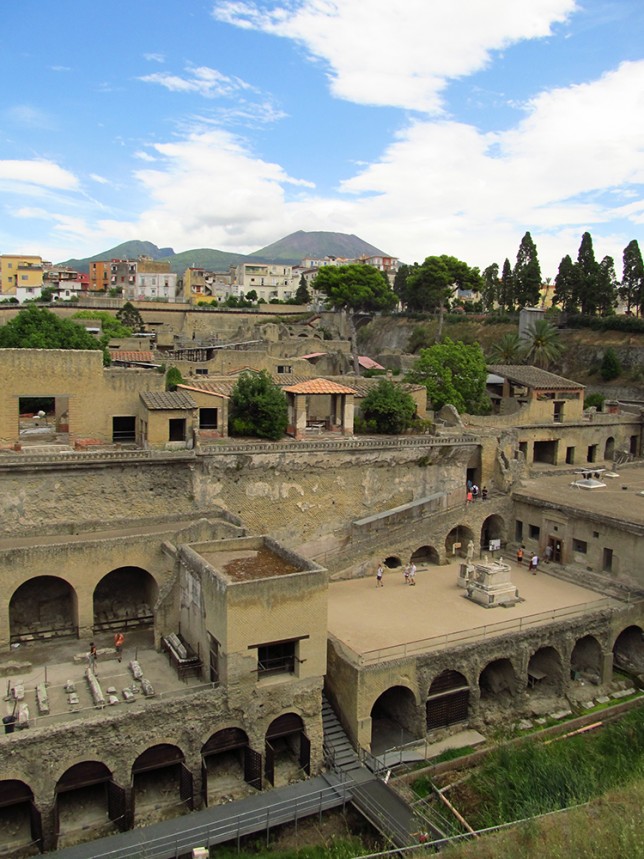
I recently visited Pompeii and Herculaneum on a visit to Italy with my family. This is my report of the visit.
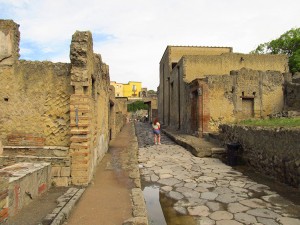
We went to Herculaneum first, mainly because I knew it was the smaller site and our hotel was in Pompeii itself so I wanted to get to the hotel quicker after a day of slogging around in the hot sun. Herculaneum is also the more interesting site to me because it is better preserved. In many of the buildings in Herculaneum you can still see the charred wood beams sticking out. Unfortunately, neither Pompeii nor Herculaneum have anything remotely resembling a museum displaying artifacts found in the ruins, there is just the ruins themselves. There is a huge museum in Naples that has artifacts but we did not go there this trip. I only really wanted to see what was extant in the ruins anyway.
If you go to Pompeii first you can buy a 3-day ticket that is good for Pompeii, Herculaneum, Stabia, and Oplontis for about €12. I only had one day and since I started in Herculaneum I paid about €11 per person for the two sites. EU citizens under 18 get free admittance and EU citizens under 25, disabled, the elderly, and students pay half price, since I am a scumbag American I paid full admission, it was worth it though.
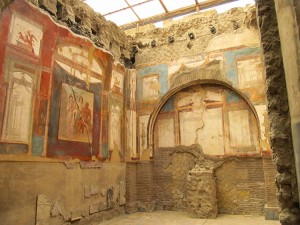
Herculaneum was buried under 66m of ash that hardened into tufa, which is harder to dig through. It was also covered more quickly and thus better preserved. To get into the site you have to walk through an arch and go about 150m into the site to the visitor center where you can buy your tickets, there is also a parking lot on the site about 50m from the visitor center. Supposedly backpacks are not allowed into the site but that prohibition was ignored by most people except for us who had to carry our water bottles in a plastic bag they gave us. They will check your backpack for no fee though, which was nice. We got a map and information booklet at the ticket kiosk. You can also get an audio-guide in several different languages before entering the site, you do have to give up and ID card as deposit for it though.
Now for the sites themselves. To get to the actual site of Herculaneum you walk through a tunnel which brings you out what would have been just offshore during the eruption. On the left you will see some boathouses full of skeletons. This is the most recently excavated part of the city and over 300 skeletons were found in these boathouses when they were excavated in the 1980’s. There are essentially three main streets excavated so far and several cross streets. Many of the houses still have the wood beams within the structure and they have been covered with Plexiglas to prevent deterioration. It takes about 1-2 hours to walk through the entire site.
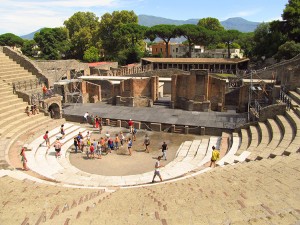
Now to Pompeii. Pompeii is by far the most well-known of the buried cities around Mt Vesuvius and it gets the most visitors. We got to Pompeii shortly after lunch and luckily found parking just across the street from the entrance that we only had to pay €8 for. Just outside the gate was the typical multitude of stands hawking souvenirs and several food/snack bars that sold outrageously overpriced food. There is only one entrance to the site and we waited in line for almost 30 minutes to buy our tickets. We asked about a map and were told we can get one and an audio-guide after entry.
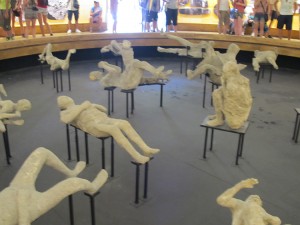
When got inside we were told you get them at the entrance so we visited the site without a map. Luckily, I am familiar enough with the map that I knew roughly where I wanted to go and we managed to find everything we wanted to see. Pompeii itself is huge and it is entirely possible to get lost walking around.
The first thing you see on entering the site is the Theater. We then walked all the way to the other end of town stopping in numerous buildings along the way to see the amphitheater. Inside the amphitheater they had a temporary display set up in a wooden pyramid on the floor of the arena that displayed some of the casts of victims of the eruption and a photo montage along the interior wall.
One of the most interesting things I saw was an old vineyard within the ruins that has been replanted with vines that roughly correspond to what was there at the time of the eruption. The vines were planted in the same places as the roots of the vines at the time of the eruption. A wine is even made from the fruit and sold although I did not buy any. Many of the structures are covered and blocked off and there is evidence everywhere of the stabilization and conservation work that began after the House of the Gladiators collapsed in 2010. That is the main reason so much of the site is closed to visitors.
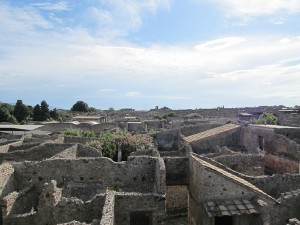
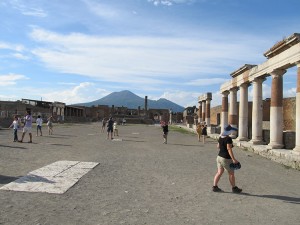
After the amphitheater we walked back the entire length of the town to get to the Forum. Along the way we stopped and waked through the central baths, which are very impressive. The Forum is pretty impressive but by the time we got there we had already been inside or almost five hours and were pretty worn out so we did not stay long. The exit to the site is just past the forum and lets you out on the other side of the plaza where the exit is.
We spent roughly 5 ½ hours inside Pompeii and saw quite a bit but much of the site is closed to visitors and the signage in the site is fairly pathetic. Without a map you are essentially looking at ruined buildings with very little idea of what the particular ruin you are looking at was. There is an unexcavated section in the center of the site that has a bathroom on top and supposedly there is a café somewhere inside the site although we did not see it. Regardless Pompeii is pretty impressive and if that is what a mid-size, unimportant town looked like in antiquity how impressive must Rome have been. Altogether, Pompeii and Herculaneum are worth the visit and it is one more thing off my bucket list. I just wish we had had the time to visit Stabia, and Oplontis as well but since we only had one day we did not get to them.
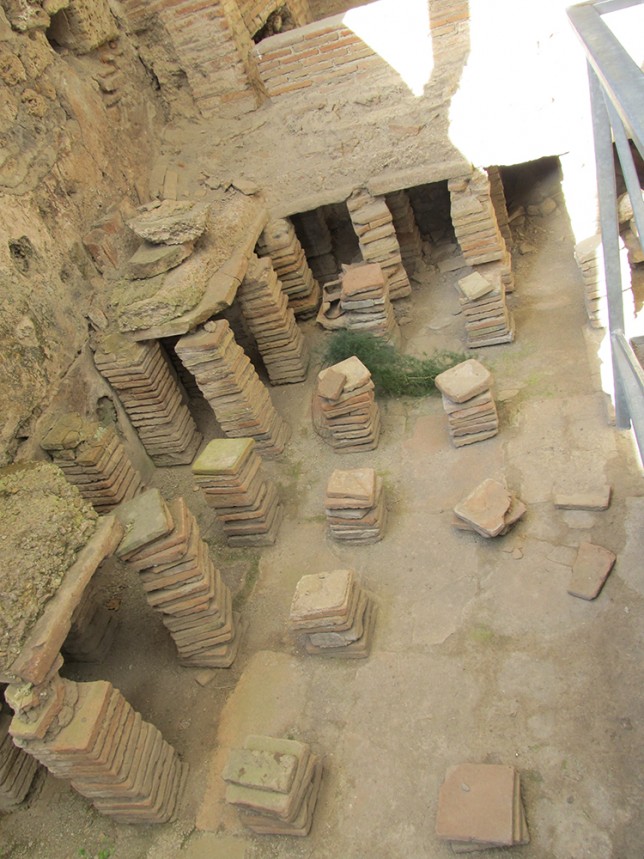

Wow, that sounds like a cool trip. That photo of Herculaneum shows something I didn’t realize – you can actually go on to the second story of some of the ancient buildings…? I also would like to ask – did you visit any of the villas outside the ancient walls of Pompeii? I recall that there was a villa (the Villa of the Mysteries) near the walls, but I guess it may have been within the paid area where tourists go. Anyway, I find this whole topic interesting as I did an independent study on the Roman domus and villa in grad school. Would like to go to Pompeii someday.
I only had one day to sightsee so I only visited the main sites of Herculaneum and Pompeii. I wanted to visit the Villa of the Papyri but ran out of time. You could easily spend a minimum of a week seeing everything, we just a did a quick walkthrough of Pompeii because it is so huge even with so much closed off. I did visit the Cannae battlefield on this trip too, but that is for an upcoming post.